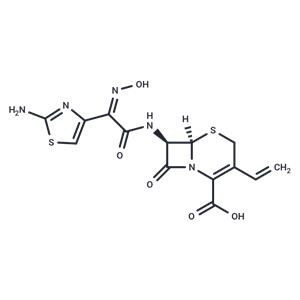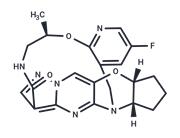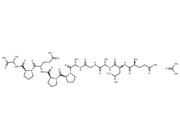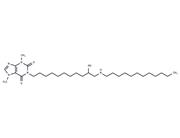| Name | Cefdinir |
| Description | Cefdinir (FK-482) is a third-generation, semi-synthetic cephalosporin antibiotic effective against common bacterial infections of the ear, sinus, throat, and skin. |
| Kinase Assay | Topoisomerase II activity assay: Nuclear extracts are prepared, and nuclei are isolated. The activity of topoisomerase II is calculated from the percentage of decatenation obtained. Tritiated kinoplast DNA (KDNA 0.22 μg) is used as a substrate. Etoposide and topoisomerase II are incubated for 30 min at 37 ℃ and are stopped with 1% sodium dodecyl sulfate (SDS) and proteinase K (100 μg/mL). The percentages of decatenation and inhibition of topoisomerase II by Etoposide are obtained. |
| In vitro | Cefdinir, a new oral 2-amino-5-thiazolyl cephalosporin, inhibits the luminol-amplified chemiluminescence (LACL) response of human neutrophils stimulated by PMA but not opsonized zymosan, in a concentration-dependent but not time-dependent manner. Cefdinir inhibits LACL generation in cell-free systems consisting of Water2, NaI, and either horseradish peroxidase or amyeloperoxidase-containing neutrophil extract. Cefdinir impairs LACL response induced by the calcium ionophore A23187 and FMLP, and this impairment is increased in cytochalasin B-treated neutrophils. Cefdinir directly inhibits the activity of myeloperoxidase-containing neutrophil extract released into the extracellular medium during neutrophil stimulation by soluble mediators, but has no effect on that released into the phagolysosome during phagocytosis. [1] Cefdinir demonstrates excellent activity against a wide range of gram-positive and gram-negative bacteria. Cefdinir is resistant to a broad variety of β-lactamases and exhibits a β-lactam stability profile generally better than those observed with cefaclor and cefuroxime. Cefdinir elimination is primarily mediated by the kidney. Cefdinir interacts with the dipeptide transporters PEPT1 and PEPT2. Cefdinir tubular reabsorption is substantial, that Cefdinir tubular secretion is inhibitable by probenecid, and that this secretion is probably mediated by the renal organic anion secretory pathway. [2] |
| Storage | store at low temperature | Powder: -20°C for 3 years | In solvent: -80°C for 1 year | Shipping with blue ice. |
| Solubility Information | DMSO : 40 mg/mL (101.16 mM), Sonication is recommended.
Ethanol : < 1 mg/mL (insoluble or slightly soluble)
H2O : < 1 mg/mL (insoluble or slightly soluble)
|
| Keywords | cephalosporin | CI 983 | PD-134393 | Inhibitor | Bacterial | Antibiotic | Gram-positive | Gram-negative | PD134393 | Cefdinir | inhibit | CI983 | FK 482 | bacteria | FK482 |
| Inhibitors Related | Neomycin sulfate | Dehydroacetic acid sodium | Ampicillin sodium | Methyl anthranilate | Kanamycin sulfate | G-418 disulfate | Sulfamethoxazole sodium | Metronidazole | Doxycycline | EDTA copper(II) disodium salt | Dimethyl sulfoxide | Crystal Violet |
| Related Compound Libraries | Bioactive Compound Library | Antibiotics Library | Drug Repurposing Compound Library | NO PAINS Compound Library | FDA-Approved Drug Library | Anti-Aging Compound Library | Bioactive Compounds Library Max | Anti-Infection Compound Library | Anti-Metabolism Disease Compound Library | Human Metabolite Library |

 United States
United States



